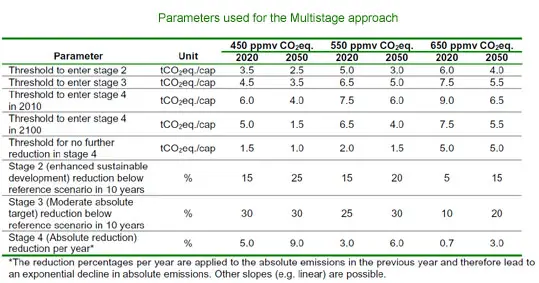Multistage Emissions Reduction Approach
As the name suggests in a Multistage Emissions Reduction approach countries participate in several stages, with differentiated types and levels of commitments. Each stage has stage-specific commitments with countries graduating to higher stages when they exceed certain thresholds (e.g. emissions per capita or GDP per capita). All countries agree to have commitments at a later point in time. For this analysis thresholds based on per capita emissions with four stages were applied as follows (e.g. Höhne et al. 2005):
Stage 1 – No commitments: Countries with a low level of development do not have climate commitments under the Multistage Emissions Reduction model. As a minimum all least developed countries (LDCs) would be in this stage. In the model countries in this stage follow their reference scenario as no emission reductions are required.
Stage 2 – Enhanced sustainable development: At the next stage, countries commit in a clear way to sustainable development: The environmental objectives have to be built into the development policies. Such a first ‘soft’ stage would make it easier for new countries to join the regime. Requirements for such a sustainable pathway could be defined, e.g. inefficient equipment is phased out and requirements and certain standards are met for any new equipment, or there is a clear deviation from the current policies depending on the countries. This stage is implemented in the model by assuming countries reduce emissions by a percentage below their reference scenario within 10 years and then follow the reduced reference scenario.
Stage 3 – Moderate absolute target: In this stage of the Multistage Emissions Reduction approach, countries commit to a moderate target on absolute emissions. The emission level may be higher than the starting year, but it should be below a reference scenario. The target could be positively binding, meaning that allowances can be sold if the target is exceeded but no allowances have to be bought if the target is not achieved. An incentive to accept such a target would be the possibility to participate in emissions trading. To model the group of countries in this stage, a percentage reduction below their reference scenario more stringent than in stage 2 is assumed.
Stage 4 – Absolute reduction target: Countries in stage 4 receive absolute emission reduction targets and have to reduce their absolute emissions substantially until they reach a low per capita level (essentially a fifth stage). The whole group of countries reduces its emissions as a certain percentage compared to 1990. The actual contribution of each country depends on its per capita emissions. Countries with high emissions per capita have to reduce more than countries with low emissions per capita. As time progresses, more and more countries enter stage 4.
The parameters for reductions and stage participation thresholds chosen for the calculations are given in the Table below. The choice of parameter values is subjective but should reflect a reasonable burden sharing of emission reductions among developed and developing countries. Several other options are possible. Lower stage-thresholds, for example, would require higher contributions of developing countries.

The parameters in the 650 ppmv CO2eq. case could have a realistic chance of being acceptable to many countries: The second stage (pledge for sustainable development) would require 5 to 15% reduction below the reference scenario, the third stage (moderate reductions) would require emission to be 10 to 20% below reference.
Participation in stage 4 (absolute reduction target) would be at 9 tonne carbon dioxide equivalent per capita (tCO2eq./cap), which is between current Annex I and world average. The reduction obligations would still be ambitious with 0.7 to 3% reduction per year. The parameters for the 550 ppmv case are much more stringent: The second stage (pledge for sustainable development) would already require emissions to be reduced by 15 to 20% below reference; the third stage (moderate reductions) would require reductions of 25 to 30% below reference. Participation in stage 4 (substantial reductions) would be at about current world average. The reduction obligations would be ambitious with a 3 to 6% reduction per year.
The parameters needed for the 450 ppmv CO2eq. case stretch the approach to its limits: participation in stages 2 and 3 has to occur almost immediately for most developing countries. Already in stages 2 and 3 reductions of 15 to 25% and 30% respectively have to occur. Countries at stage 4 have to reduce emissions drastically by 5% to 9% per year.
This material is extracted from: Niklas Höhne, Dian Phylipsen, Sara Moltmann,Factors underpinning future action 2007 update, Department for Environment Food and Rural Affairs, United Kingdom.
The complete report including the section on the Multistage Emissions Reduction approach is available here
